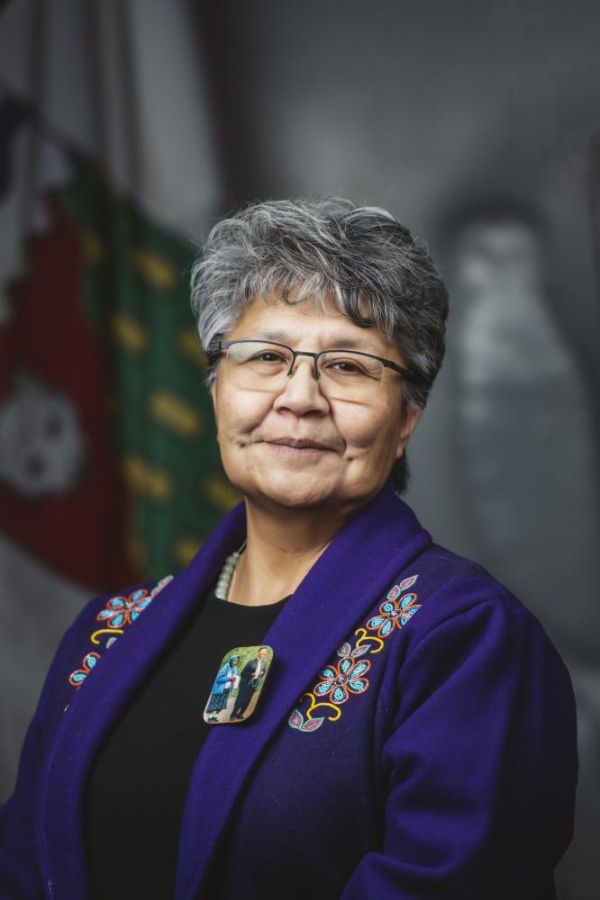
Yes, we'll make a commitment to get the report to committee. And as for progress, we will have to discuss with committee what he means by "progress" and what timelines that the committee's looking for. Is it monthly? Is it quarterly? Is it annually? As we move forward. So before I make a commitment on that, I'd like to get some clarity from committee on that. Thank you.

Mahsi. Mr. O'Reilly.

Thanks, Mr. Chair. I'm a very patient man. I've been waiting six years. So any kind of progress reporting would be really helpful. But I'll leave it at that. That's all my questions on this activity. Thanks, Mr. Chair.

Mahsi, Mr. O'Reilly. Ms. Nokleby.

Thank you, Mr. Chair. Mr. Chair, I just wanted to ask a bit of a question for more detail on the dust suppressant that the deputy minister mentioned. I'm just curious to know is this for the tailings that's adjacent to the roadway and which type of dust suppressant are they looking at? Thank you.

Mahsi, Ms. Nokleby. Minister.

For that detail, I'm going to the deputy minister. Thank you, Mr. Chair.

Deputy minister.
Thank you, Mr. Chair. It is the tailings that are near the roadway, and I'm sorry, but even I do not have that level of technical detail in this binder right now. We can certainly get back to folks, if the Minister's okay with that, with the type of dust suppressant. Thank you, Mr. Chair.

Mahsi. Ms. Nokleby.

Thank you, Mr. Chair. I think I'm a bit of a nerd from my time at Giant Mine which is why I'm curious to know what's being explored for Ptarmigan and do urge the department and the Minister to chat with the Giant Mine folks about their issues in spreading dust suppressant throughout the windy conditions of the Northwest Territories. And I see a nod. So I'll just take that as a comment.
I guess my question is around again, with Ptarmigan, and I appreciate my colleague raising it. With the land use permit work being done underway, is it and while we're still negotiating within the accepted waste sites under devolution, can we still continue to progress on with the remediation work there? And I guess it is a little bit the similar question to what Member O'Reilly was asking, but will the process delay remediation work as we go through the devo process, or can we continue to advance during that time? Thank you.

Mahsi, Ms. Nokleby. Minister.

Thank you. We'll get the dust suppressant information to her. In regards to that detail, I want to say yes, but I'm going to turn to the deputy minister to get clarity on what the process is moving forward. Thank you.

Deputy minister.
Thank you, Mr. Chair. That's what's being negotiated right now. Clearly, we're doing the work on the land use permits, and we're hopeful that we can come to an agreement, and it's looking positive for us to continue with the work. But that is the crux of the negotiations that are occurring at this time. Thank you, Mr. Chair.

Mahsi. Ms. Nokleby.

Thank you, Mr. Chair. Without incriminating myself, I may have had a time or an opportunity; I've looked around the Ptarmigan Mine despite some "no trespassing" signs there. So I'm just curious to know if we're verging on to somewhat of an emergent situation at Ptarmigan? I know that there are issues with a head frame and probably likely stability and such of some of the buildings. I'm not sure if there's an open raise or shaft there. I see my colleague nodding his head yes. So what point would we get to where it becomes a hazard to the point where we have to do something ahead of that agreement being reached, and is there a process for us to do so? Thank you.

Mahsi, Ms. Nokleby. Minister.

For that detail, deputy minister. Thank you.

Deputy minister.
Thank you, Mr. Chair. So even though the negotiations are ongoing to determine who's ultimately responsible for those sites, the GNWT put up fencing quite some time ago. There's boulders, there's signs, getting people to not go on the site, which is an attempt to address some of the concerns that have been put forward. So until we know who is ultimately responsible, we're trying to keep people off of the site so that those things are not addressed.
Clearly, we need to determine who's responsible so that we can move forward, and that's what we're working hard on at this point. And I can honestly say that there have been conversations recently at the deputy level trying to move this, and I'm hopeful that we'll be able to make progress. Thank you, Mr. Chair.

Mahsi. Ms. Nokleby.

Thank you, Mr. Chair. And I would like to say that I was on the site long before all the signs went up and the fencing. It just looked really neat. So we wandered off the highway.
And I guess my final question on that, then, is, you know, are we on the hook, then, as the GNWT for that in the meantime? Is there and I know again I'm probably just reiterating Mr. O'Reilly, but I maybe was not always listening to the answer. So, you know, are we able to recoup that at some point? Thank you. I'll just ask again.

Mahsi, Ms. Nokleby. Minister.

For that detail, deputy minister. Thank you.

Deputy minister.
Thank you, Mr. Chair. That is the crux of the negotiations that we're having right now, is who is responsible for paying for the remediation of those sites. Not just Ptarmigan, the suite of accepted sites. And that's all I can really comment on at that time because the work is ongoing. Thank you, Mr. Chair.

Mahsi. Ms. Nokleby.

I just want to say I appreciate the Minister and deputy minister's patience, as you can understand that from this side we definitely want you to be asking for that money to be paid for by the federal government regardless, you know, if we do end up doing the remediation work ourselves. Some of it seems like it's their stalling that has let the mine to get to that state for so long. So I feel like we should hold them accountable. And again, just a comment. So thank you.

Mahsi. No other questions from committee? Oh, we have got a couple. Mr. Simpson.

Thank you, Mr. Chair. I just I think I'm in the right spot here hopefully. Environmental stewardship stewardship and climate change? Oh, sorry, I think it was the next one.
Laughter

Environmental protection and waste management. It goes up to page 78. You good? Okay, I'll move on to Mr. Edjericon.
Yes, thank you, Mr. Chair. I just had a question for the Minister.
Since devolution, it's my understanding that the contaminant sites, does the GNWT take responsibility of the contaminated sites, or is it my understanding it's still the responsibility of the Government of Canada?

All right. Mahsi. Maybe just to remind committee if we can indicate that you're done with your question by saying. Minister.

Thank you. So those six sites are part of the negotiations. We didn't take them over from devolution. But for further detail, maybe I'm wrong, so maybe I'll look at the deputy minister. She just touched her brow so I think I might have said the wrong thing. So to get the clarity, I'll have to go to the deputy minister. Thank you.

Deputy minister.
Thank you, Mr. Chair. So there are still federal sites that are on federal land. There's some that we're negotiating. There's some that the federal government is remediating, and then they're asking us to take back, and we need to do the work to figure out if we want to accept those are not. And there's some that are GNWT sites that were contaminated sites before devolution, and they remain ours. So there's multiple ways, but there's still federal contaminated sites that are the responsibility of the federal government. There's some that we're negotiating here that are called accepted waste sites. There's some that we agreed that they would remediate and give back to us, and then there's some that were ours to begin with. Thank you, Mr. Chair.

Mahsi. Mr. Edjericon.
Thank you for your answer. Also, can you tell me exactly how many contaminated sites are there, we're looking at here? I'm assuming you guys did the study, that for the Northwest Territories. The question is to the Minister. Thank you.

Mahsi, Mr. Edjericon. Minister.

For that detail, I will turn to the assistant or the deputy minister. Thank you.

Deputy minister.
Thank you, Mr. Chair. There were 1,319 sites that were transferred to the GNWT through devolution. An additional 99 sites will be transferred to the GNWT once the Government of Canada has completed the remediation work to the GNWT's satisfaction. A further 20 sites are being negotiated with the Government of Canada regarding responsibility. And I've already mentioned the different categories of the sites. So thank you, Mr. Chair.

Mahsi. Mr. Edjericon.
Thank you for that. Now that you told me those numbers on that, has your department or to the Minister, has your department gone out to figure out the actual cost to remediate these mine sites in broad numbers so we I don't see any numbers here but I'm asking that question to you. Thank you.

Mahsi. Mr. Edjericon, since you're kind of new, I'll direct all your questions to the chair and then when you're done your question, maybe you can just indicate that you are done by saying "thank you" or recognizing the chair. Mahsi. We'll move along. Minister.

Thank you. So before I put my foot in my mouth, as the Member was asking the question I thought we were just talking about the six sites and not the whole gamut. But for that detail, I'm going to turn to the deputy minister. She has the numbers, I believe. Thank you, Mr. Chair.

Deputy minister.
Thank you, Mr. Chair. So to be clear, these are not all mine sites. Some of these are just small sites on the landscape. And the GNWT uses a risk management approach, and we work with Finance and other departments on that. And there is a liabilities fund that can fund some of the remediation. But the decisions on what will be remediated are dependent on the level of risk. So we prioritize high priority sites to action with the funding that we do have. Thank you, Mr. Chair.

Mahsi. Mr. Edjericon.







